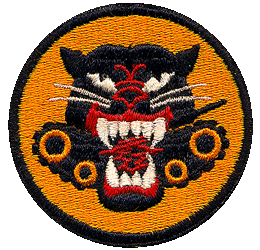 Homer E. Griner
Homer E. Griner
Biography: Homer Eugene Griner was born on April 18, 1918, in Winnett, Montana. He was the son of Francis C. Griner and Caroline L. Pollmann. The 1930 U.S. Census shows the family living in Hilcrest, Washington. His enlistment record shows he completed four years of high school. His draft card, dated October 16, 1940, indicates he was working for the U.S. Army Corps of Engineers on the Kannapolis Dam near Ellsworth, Kansas. On January 7, 1943, Homer married the former Dorothy L. Branda in Wilson, KS. She was born in Wilson and was the daughter of Charles Branda and Lillian I. Jirik. The couple had two daughters, Paulette, born in 1947, and Dorene in 1949.
Service Time: Homer entered the Army on March, 14, 1942, at Fort Lewis, Washington, and on the 19th, he was assigned to and joined Company B of the 607th Tank Destroyer Battalion in Sunnyvale, California. He trained with the unit at a number of locations including: Camp San Luis Obispo, Hunter Liggett Military Reservation and the Desert Training Center, all in California, along with Camp Hood, Texas and Camp Cooke, CA. He was promoted to PFC (Private First Class) on May 14,1942 and Technician Grade 5 on January 13, 1943.
 Arriving at Liverpool, England, on April 21, 1944, they continued training. Company B landed at Utah Beach, Normandy, France on June 23rd and supported the advance on Cherbourg, fighting along the Seves River in July. They joined the drive to Le Mans and envelopment of the Falaise Pocket in August. On August 19th, near Ste. Eugenie, France, one of the units 3” anti-tank guns received direct hostile small arms and artillery fire which could not be effectively returned from its concealed location. Homer was part of the crew which, in the face of enemy fire, seized the trails of the gun and pushed it forward by hand to an exposed position one hundred yards from the enemy’s line. From this position the gun destroyed an enemy tank, four other vehicles, and an enemy self-propelled gun which had prevented the advance of our troops. For their heroic action, Homer and all members of the crew received the Silver Star Medal.
Arriving at Liverpool, England, on April 21, 1944, they continued training. Company B landed at Utah Beach, Normandy, France on June 23rd and supported the advance on Cherbourg, fighting along the Seves River in July. They joined the drive to Le Mans and envelopment of the Falaise Pocket in August. On August 19th, near Ste. Eugenie, France, one of the units 3” anti-tank guns received direct hostile small arms and artillery fire which could not be effectively returned from its concealed location. Homer was part of the crew which, in the face of enemy fire, seized the trails of the gun and pushed it forward by hand to an exposed position one hundred yards from the enemy’s line. From this position the gun destroyed an enemy tank, four other vehicles, and an enemy self-propelled gun which had prevented the advance of our troops. For their heroic action, Homer and all members of the crew received the Silver Star Medal.
Advancing to the Moselle River in September, they supported operations against Metz through November. The unit converted to a self-propelled battalion equipped with M36 tank destroyers in time for the final assault on Metz. Continuing the drive toward the Saar River, they participated in the attack on Saarlautern, Germany in December.
On December 5th, Homer was Lightly Injured in Action (LIA) that day, receiving 1st and 2nd degree burns on his face and hands. He was evacuated to the 109th Evacuation Hospital and dropped from assignment as a battle casualty. Unit records do not contain any information regarding how he was injured and they do not show he returned to the unit.

In addition to the Silver Star, Homer was awarded a Purple Heart Medal, the EAME Medal, with credit for the campaigns of Normandy, Northern France and Rhineland, along with the Good Conduct and WWII Victory Medals. He was discharged on December 21, 1945, at the rank of Technician Grade 5.
Homer returned home to Dorothy and at some point returned to work for the Corps of Engineers as an inspector, eventually retiring from the Corps. He passed away on March 14, 1984, and was buried in the Gypsum Hill Cemetery, Salina, Kansas. Thank you to Ancestry member Arne Griner for use of the photos of Homer and Dorothy. Thank you also to Find A Grave contributor “sister7a” for use of the grave marker photo.
